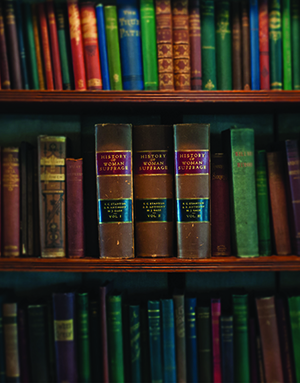
Long before Rotary International called Evanston home, the famous suffragist and temperance reformer Frances Willard made the city the informal headquarters of another international organization: the Woman’s Christian Temperance Union. Today, the operations of the Union have almost disappeared from the small, green house on Chicago Avenue and the brick building hiding behind it, but a team of volunteers is dedicated to making the resources left there available to the world.
The Willard House on Chicago Avenue—the Willard family’s second home in Evanston—was completed in 1865, six years before Frances Willard became dean of women at the Woman’s College of Northwestern University, and only 14 years before she was elected national president of the WCTU.
Six years into Willard’s term as WCTU president, the organization still didn’t have an official central office. The WCTU national headquarters moved around for the first few years, says Mary McWilliams, who served as a board member of the Frances Willard Historical Association from 1996 to 2012. McWilliams is currently the coordinator of tours and programs.
“They hadn’t really settled on a home for themselves, but Frances said, ‘I’m president, we might as well move it where I am,’” McWilliams says.
The organization accepted Willard’s proposal to move to Chicago, a central location with rail connections to nearly everywhere in the country. Willard and the WCTU recruited one of the most popular architectural partnerships of the day, fellow Evanstonian Daniel Burnham and Chicagoan John Root, to build an expensive women’s temple in downtown Chicago.
“Frances was a staunch supporter of the building,” McWilliams says, “And at her last national convention in 1897 she pledged [her home] as collateral.”
However, her home was not enough to cover the nearly $150,000 (more than $4 million today) needed to keep the building when the Union failed to sell enough office space in the skyscraper. In 1900, the headquarters of the WCTU moved to the Willard House.
The WCTU evicted the house’s residents and set up offices in the home’s northern portion. When the organization started the Frances Willard House in the southern half, it became the first museum in the United States dedicated solely to the life of a woman.
WCTU’s time spent cramped in the Willard home’s tiny space didn’t last long. With the temperance movement gaining traction and talk of a prohibition amendment building, the WCTU decided to expand its office space.
“At that time, you could build an office building in your backyard,” McWilliams says. “There were no zoning ordinances.”
The Union did exactly that. It hired local architect Charles Ayars (who designed Chapin Hall) to build a small office building, called the Literature Building, in the backyard of the Willard House.
The building expanded slowly for the next few decades, finally reaching its current size in 1940, when the Frances E. Willard Memorial Library for Alcohol Research was added to celebrate the centennial of Willard’s birth.
Because the majority of the Union’soperations moved away from Evanston in 1996, the library has become one of the most important features of Evanston’s oldest National Historic Landmark.
Today, the library contains a plethora of important artifacts, including Frances Willard’s papers, records of branches of the WCTU from around the world, liquor licenses dating back to the 17th century and even an original copy of the first scientific analysis of the effects of alcohol by famous physician Benjamin Rush.
When Janet Olson, the assistant university archivist at Northwestern, first took over as volunteer archivist in 2007, the library had suffered from years of neglect. Many of the treasures were hidden in plain sight, lost under mountains of papers stacked on desks, filling up closets and covering the floors.
“I’m still engaged in triage,” Olson says. “What do we have, what does it go with, we’re still so far from processing.”
Many years from now, Olson hopes the library can expand its services and operate similarly to the University Archives. Her work has already attracted researchers from around the world to use the collections. “One lady was just here from Switzerland for two weeks, looking at the stuff we had on India,” Olson says.
Whether Olson’s dream can come true will depend in part upon the cooperation of the modern WCTU, which despite owning a wealth of archival resources, continues to devote a lot of attention to educating young people about the dangers of alcohol, tobacco and drugs. The Frances Willard Historical Association oversees the Willard House and WCTU property.
“We’re beginning to succeed in impressing the WCTU, which is sadly not all that large anymore,” McWilliams says. “This property and the contents, particularly the archives, are their legacy. The WCTU made a very significant contribution to American history, and they ought to preserve it.”